Detailed explanation of shared locks and exclusive locks in mysql
The mysql lock mechanism is divided into table-level locks and row-level locks. This article will share with you my sharing and exchange of shared locks and exclusive locks in row-level locks in mysql.
Shared lock is also called read lock, or S lock for short. As the name suggests, shared lock means that multiple transactions can share a lock for the same data, and they can all access the data, but they can only read and cannot modify it.
Exclusive lock is also called write lock, referred to as Other locks include shared locks and exclusive locks, but the transaction that acquires the exclusive lock can read and modify the data.
Everyone may have a good understanding of shared locks, that is, multiple transactions can only read data but not modify data. However, everyone may have a different understanding of exclusive locks. I made a mistake at the beginning, thinking that exclusive locks After a row of data is stored, other transactions cannot read and modify the row of data. This is not the case. An exclusive lock means that after a transaction adds an exclusive lock to a row of data, other transactions cannot add other locks to it. Mysql InnoDB engine's default data modification statement, update, delete, and insert will automatically add exclusive locks to the data involved. The select statement will not add any lock type by default. If you want to add an exclusive lock, you can use the select...for update statement. To add a shared lock, you can use the select ... lock in share mode statement. Therefore, the data rows with exclusive locks cannot be modified in other transactions, and the data cannot be queried through for update and lock in share mode locks, but the data can be queried directly through select...from..., because Ordinary queries do not have any locking mechanism.
Having said so much, let’s take a look at the following simple example:
We have the following test data

Now we have an exclusive query for the data row with id=1. Here we will use begin to open the transaction, and we will not see me closing the transaction. This is for testing, because committing the transaction or rolling back the transaction will release the lock.
Open a query window
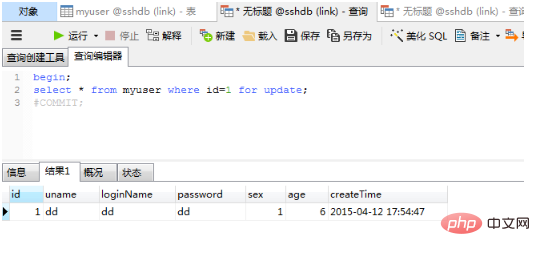
A piece of data will be queried. Now open another query window and use exclusive query and shared lock query for the same data. A way to query
Exclusive query
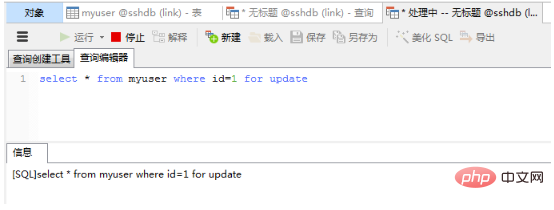
Shared query
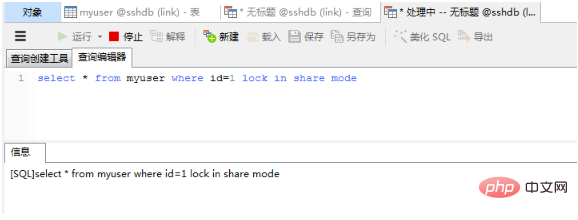
We see that the exclusive lock is turned on Both query and shared lock query will be in a blocking state, because the data with id=1 has been locked with an exclusive lock, and the blocking here is waiting for the exclusive lock to be released.
What if we directly use the following query

#We see that the data can be queried.
Let’s take another look at a transaction that acquires a shared lock. In other queries, we can only add shared locks or not.

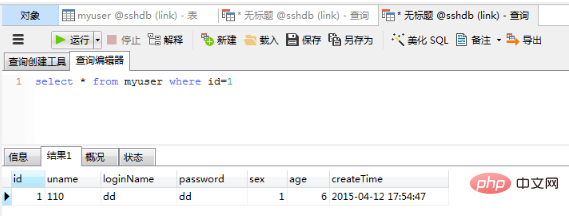
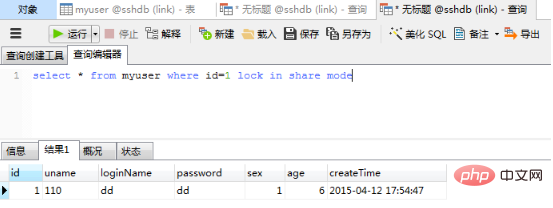
We see that the data can be queried, but it cannot be found with an exclusive lock. , because exclusive locks and shared locks cannot exist on the same data.
Finally, we verify the problem of automatically adding exclusive locks to the update, delete, and insert statements in the mysql InnoDb engine mentioned above.
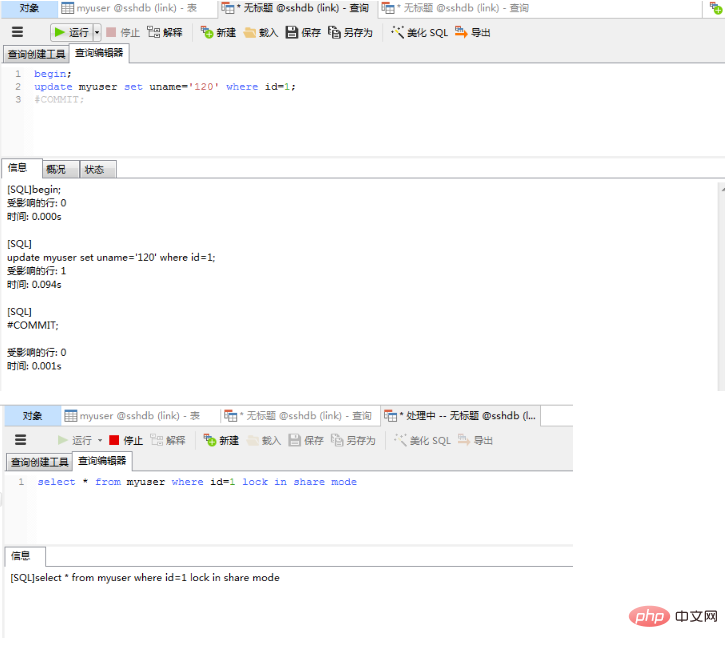
At this time, the shared query is in Blocking, waiting for the release of the exclusive lock, but the data can be found using ordinary queries, because the locking mechanism is not mutually exclusive with the exclusive lock, but the data found is the old data before the data is modified.
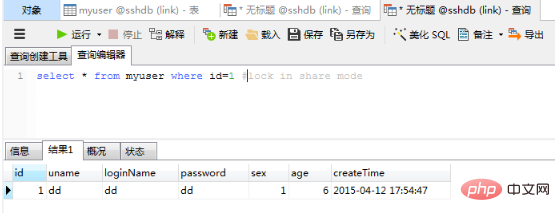
Then we submit the data, release the exclusive lock and look at the modified data. At this time, exclusive query, shared query and ordinary query can be used, because the row data is released after the transaction is submitted. Exclusive lock, only ordinary queries are displayed below, other students can verify by themselves.
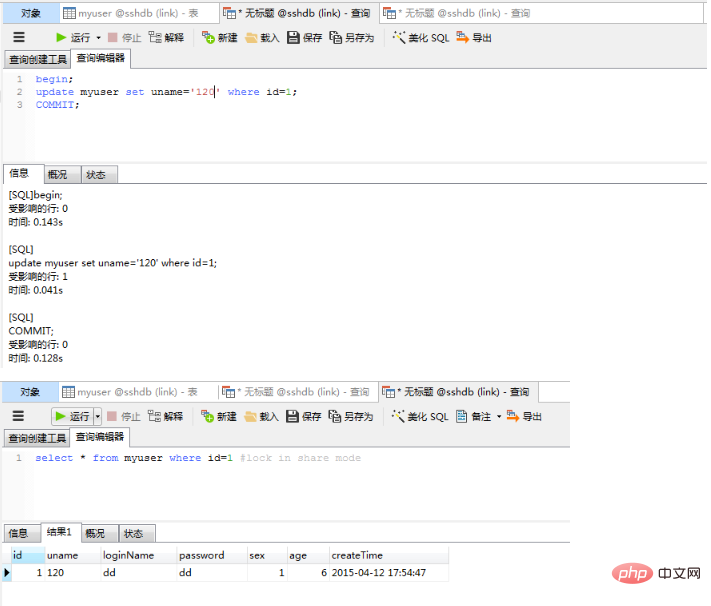
You can see that the results are as expected.
Recommended tutorial: "Mysql Tutorial"
The above is the detailed content of Detailed explanation of shared locks and exclusive locks in mysql. For more information, please follow other related articles on the PHP Chinese website!

Hot AI Tools

Undresser.AI Undress
AI-powered app for creating realistic nude photos

AI Clothes Remover
Online AI tool for removing clothes from photos.

Undress AI Tool
Undress images for free

Clothoff.io
AI clothes remover

Video Face Swap
Swap faces in any video effortlessly with our completely free AI face swap tool!

Hot Article

Hot Tools

Notepad++7.3.1
Easy-to-use and free code editor

SublimeText3 Chinese version
Chinese version, very easy to use

Zend Studio 13.0.1
Powerful PHP integrated development environment

Dreamweaver CS6
Visual web development tools

SublimeText3 Mac version
God-level code editing software (SublimeText3)

Hot Topics
 1393
1393
 52
52
 1207
1207
 24
24
 How to open phpmyadmin
Apr 10, 2025 pm 10:51 PM
How to open phpmyadmin
Apr 10, 2025 pm 10:51 PM
You can open phpMyAdmin through the following steps: 1. Log in to the website control panel; 2. Find and click the phpMyAdmin icon; 3. Enter MySQL credentials; 4. Click "Login".
 MySQL: An Introduction to the World's Most Popular Database
Apr 12, 2025 am 12:18 AM
MySQL: An Introduction to the World's Most Popular Database
Apr 12, 2025 am 12:18 AM
MySQL is an open source relational database management system, mainly used to store and retrieve data quickly and reliably. Its working principle includes client requests, query resolution, execution of queries and return results. Examples of usage include creating tables, inserting and querying data, and advanced features such as JOIN operations. Common errors involve SQL syntax, data types, and permissions, and optimization suggestions include the use of indexes, optimized queries, and partitioning of tables.
 MySQL's Place: Databases and Programming
Apr 13, 2025 am 12:18 AM
MySQL's Place: Databases and Programming
Apr 13, 2025 am 12:18 AM
MySQL's position in databases and programming is very important. It is an open source relational database management system that is widely used in various application scenarios. 1) MySQL provides efficient data storage, organization and retrieval functions, supporting Web, mobile and enterprise-level systems. 2) It uses a client-server architecture, supports multiple storage engines and index optimization. 3) Basic usages include creating tables and inserting data, and advanced usages involve multi-table JOINs and complex queries. 4) Frequently asked questions such as SQL syntax errors and performance issues can be debugged through the EXPLAIN command and slow query log. 5) Performance optimization methods include rational use of indexes, optimized query and use of caches. Best practices include using transactions and PreparedStatemen
 Why Use MySQL? Benefits and Advantages
Apr 12, 2025 am 12:17 AM
Why Use MySQL? Benefits and Advantages
Apr 12, 2025 am 12:17 AM
MySQL is chosen for its performance, reliability, ease of use, and community support. 1.MySQL provides efficient data storage and retrieval functions, supporting multiple data types and advanced query operations. 2. Adopt client-server architecture and multiple storage engines to support transaction and query optimization. 3. Easy to use, supports a variety of operating systems and programming languages. 4. Have strong community support and provide rich resources and solutions.
 How to connect to the database of apache
Apr 13, 2025 pm 01:03 PM
How to connect to the database of apache
Apr 13, 2025 pm 01:03 PM
Apache connects to a database requires the following steps: Install the database driver. Configure the web.xml file to create a connection pool. Create a JDBC data source and specify the connection settings. Use the JDBC API to access the database from Java code, including getting connections, creating statements, binding parameters, executing queries or updates, and processing results.
 How to start mysql by docker
Apr 15, 2025 pm 12:09 PM
How to start mysql by docker
Apr 15, 2025 pm 12:09 PM
The process of starting MySQL in Docker consists of the following steps: Pull the MySQL image to create and start the container, set the root user password, and map the port verification connection Create the database and the user grants all permissions to the database
 Centos install mysql
Apr 14, 2025 pm 08:09 PM
Centos install mysql
Apr 14, 2025 pm 08:09 PM
Installing MySQL on CentOS involves the following steps: Adding the appropriate MySQL yum source. Execute the yum install mysql-server command to install the MySQL server. Use the mysql_secure_installation command to make security settings, such as setting the root user password. Customize the MySQL configuration file as needed. Tune MySQL parameters and optimize databases for performance.
 How to install mysql in centos7
Apr 14, 2025 pm 08:30 PM
How to install mysql in centos7
Apr 14, 2025 pm 08:30 PM
The key to installing MySQL elegantly is to add the official MySQL repository. The specific steps are as follows: Download the MySQL official GPG key to prevent phishing attacks. Add MySQL repository file: rpm -Uvh https://dev.mysql.com/get/mysql80-community-release-el7-3.noarch.rpm Update yum repository cache: yum update installation MySQL: yum install mysql-server startup MySQL service: systemctl start mysqld set up booting




